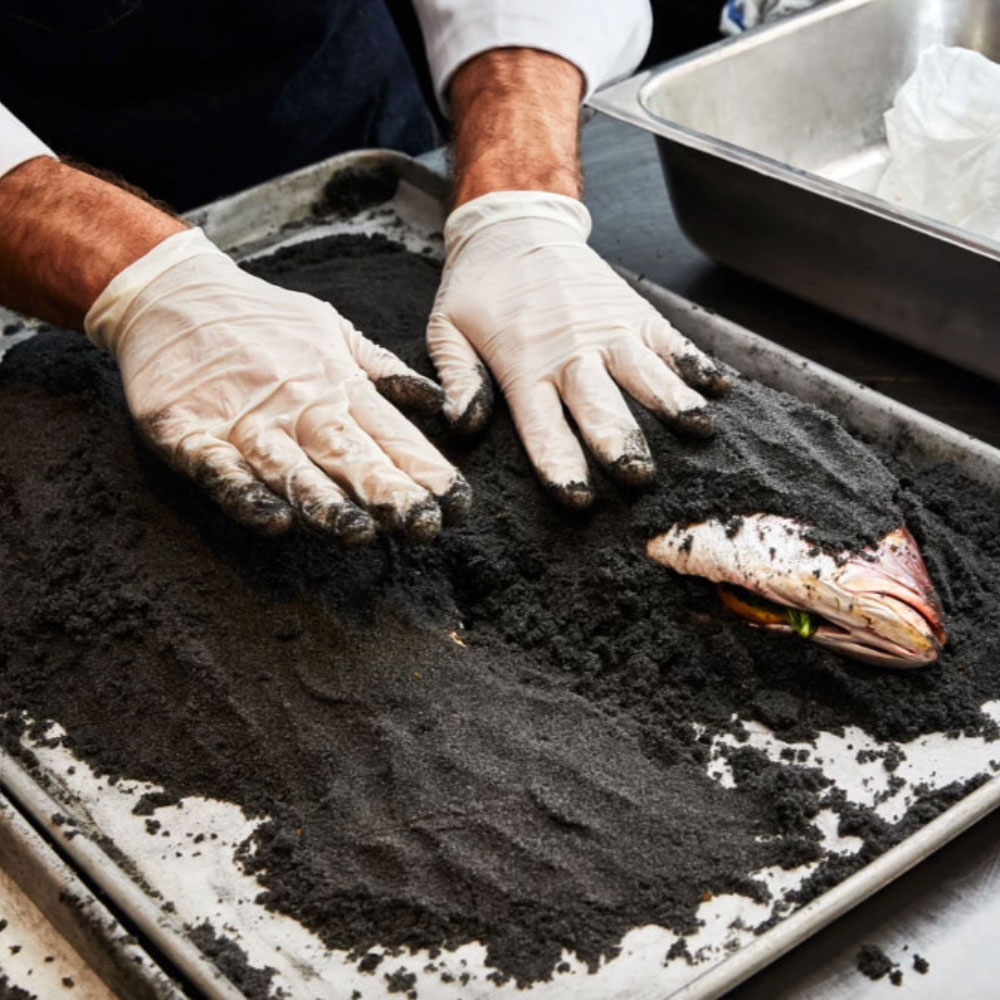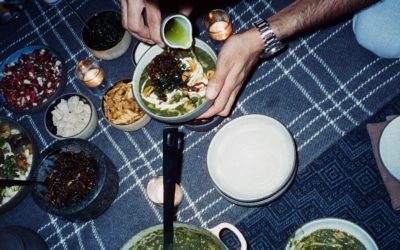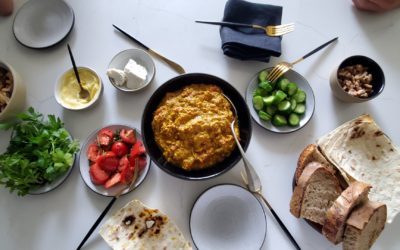There are those outstanding moments throughout life that come to define your perspective, and they are more often than not, simple gestures that we recount and re-visit later, when we have the maturity and context to look for the lessons within them. See, my mother is an incredible cook. She was the person when I was growing up who would have something on the stove cooking on Monday for a dinner on Thursday – the special dinner guests you may ask? My brother and I, always. She takes to an unbelievable degree of passion and pleasure by cooking in the kitchen; for her loved ones, her friends, co-workers, sometimes my dad (the taking pleasure part) – her greatest gift is her gesture of nourishing people. Very often, my mother struggles to put into words, the depth of her love, and when you sit down to any dish she’s ever made for you, you instantly identify the density behind her gesture.
Behzad Left, Mahin (Mom) Right – Celebrating Their Shared Birthday
When I was growing up, I remember coming home one day from school and opening up the door to a dense cloud of intoxicating air made from fenugreek & other frying herbs. The smell was astringent and medicinal, I thought our home smelt of a poor maintained hospital. In my ignorance, and partly out of my immaturity, I went up to my mom in an aggressive fit, and asked “why do you continue to cook this dish and stink up the whole house?” she replied to me with some poise, considering my tenacity to challenge her; “when I left Iran, I had nothing, I lost my parents, my town, I lost everything. Cooking this is the only thing I have from home – I cook ghalieh and I’m home. With my mother and dad, my siblings, my neighbors – everyone.” – Honestly, thinking about it further, and knowing her, she most likely yelled at me.
I didn’t understand what she was telling me then, I might have been more concerned with the smell of my clothing, or how the kids the next day would tease me about my lunch. It wasn’t until I moved to New York with absolutely no one and nothing with me before I realized how critical that moment was. I burned inside; inspired, to cook the Persian food from my mother’s home when I moved into my first place on Avenue D. Nothing could fill the longing to be with my family more than the act of cooking something from home. The pure process of aromatizing a foreign place with the scents and smells of her kitchen purified the anxiety and longing I felt so heavy in the air. The first pure Persian dish I ever made and documented landed me a critical job offer and a Top Chef audition, all from a social media post. We don’t say this in Iran, but we should start – “the proof is in the pudding”.
Photo By Nico Schinco
My mom is from a province called Khuzistan which is in the south-western part of Iran. It was the main casualty in the Iran-Iraq war of 1980; over 750,000 Iranians died, over 500,000 Iraqis, with no claim, change or gain for either side. The government ordered a “scorch earth” upon retreat and the city when I saw it for the first time as a 7 year old, looked as if the war had just ended there yesterday. Homes we’re toppled over, so much of the city deserted. I had no idea what I was looking at when I was a kid, and now I understand, too clearly, what the ramifications of war and loss look like. I wanted to create a dish that spoke to the bravery of my mother, her family, her friends – all Iranians who had to make the necessitative choice to leave their homes in search of asylum elsewhere.
This version of the dish that I do is a derivative and adaptation of the original recipe, so for anyone Iranian looking for the absolute most authentic thing, please look elsewhere. I don’t think that it is good enough, as a chef, to simply re-create or modernize a dish from my culture, but in the process of creating something new, that is inspired by something old and warren, I wanted to capture a greater narrative. A dish should be able to show you the fundamental aspects of culture, history, it’s people, their struggles, their liberations – all of these things far exceed the value of good food. There is good food everywhere, but where is the intention behind them? Why can’t food be more than something pretty on a plate? I wanted to create a dish that could honor my mother and show the density behind her experience, and her story. Because it is not what we leave that matters, but what we take with us, and she chose to take food with her – and how brave is that.

These Are The Essential Elements To Ghalieh Mahi:
– Start your stew the day before. Almost every Persian stew benefits from being rested overnight. Due to the nature of our stews, we have so many amino acids packed into one dish, that the pure process of allowing the ingredients to break done further overnight creates a flavor and texture from our dishes the following day that is often incomparable to the fresh made /day-of stew.
– Salt bake your fish. The one thing I can’t stand is overcooked proteins. We have a bad habit in Persian culture to take certain meat & fish products too far. Traditional Ghalieh Mahi has fish steaks that stew within the broth to help fortify the flavor of the entire dish, I prefer this alternative. Salt baking your fish does a few things: it helps season the flesh of the fish, it traps in moisture and allows the fish to cook with it’s own juices, and it creates a tender fish that can be easily filleted and sorted through for bones. The texture and flavor, if done right, is incomparable to any fish that has been simmered or steamed.
– Pick a fresh, oily fish to bake. My favorite fish to salt bake is snapper, because it is sightly oily, very flavorful, fresh tasting, and has a firm meaty flesh that stands up very nicely in this stew. Black bass also makes a great substitute. When you go to your local monger to buy fresh fish, ask them to gut it, but not to scale the fish. The scales of the fish help protect the flesh and assure the fish doesn’t break apart while cooking in the salt crust.
– Take your time. This is true for most recipes – take your time, don’t rush things, allow your stew to develop in stages. You’re making the outstanding decision to cook – good food has no shortcuts. Be patient, be present, be involved.

Recipe For “Ghalieh Mahi”
Spicy Southern Iranian Fish Stew With Fenugreek & Tamarind
Ingredients:
For The Stew:
– 3 Cups Cilantro, soft stems attached, chopped fine
– 2 Tbsp Dried Fenugreek
– 6 Cloves Garlic, sliced thin
– 1 Bunch Scallion, chopped fine
– 2 Large White Onions, diced small
– 2 Tsp Turmeric, ground
– 4 Pieces Amani Lime, crushed
– 1 Cup Tamarind Paste
– 1 Tbsp Aleppo Chili
– 2 Tsp Coriander Seeds
– 1 Tsp Cumin Seeds
– 1 Tsp Fennel Seeds
– 3 Cardamom Pods
– 10 Grates Nutmeg
– 1 L Fish Stock
For The Fish:
– 1 Whole Snapper (Approx. 2 ½ lbs)
– 1 Cup Egg Whites
– 5 lbs Kosher Salt
Garnish:
– 1 Handful of Cilantro Leaves, soft stems attached
– Lime Slices
Process:
For The Stew:
– Pre-heat an oven to 400°F.
– Meanwhile, heat up 3 tablespoons of canola or grape seed oil in a heavy based pot on medium heat. Add onions and a pinch of salt, and sauté until translucent, almost 3—4 minutes. The salt will help pull moisture from the onions and prevent them from burning.
– Add garlic, amani limes, turmeric, Aleppo chili, coriander seeds, cumin seeds, and fennel seeds, cardamom and nutmeg, and sauté for another two minutes. Add cilantro, scallion and fenugreek, and cook on medium low for 30 minutes, mixing consistently to assure the herbs do not burn.
– Once the herbs resemble a paste, and looks almost mucilaginous, add tamarind and cook for another 20 minutes to develop the sugars. Add fish stock and bring the stew to a simmer.
– Allow sauce to simmer on low for 1 ½ – 2 hours, the longer the better as it will develop more flavor. Alternatively, cook the stew a day in advance and allow the flavors to develop before continuing to the next step.
– Take your stew and blend until fine in either a blender or very thoroughly with a hand blender to break down the whole spices. Return the stew back to your pot. The color should have a rich, dark, green hue.
For The Fish:
– Meanwhile, line an oven safe pan with parchment paper a few inches wider and longer than the size of your fish. In a large bowl, mix together kosher salt and egg whites until evenly combined, or until the mixture resembled wet sand.
– Place ½ inch of salt down on the bottom of the pan and lay your fish directly on top of the salt. You can choose to stuff the stomach of the fish with herbs or fresh sliced lemons. Top the fish with the rest of the salt and evenly pack the salt around the fish to assure that there are no cracks in the salt cask.
– Place on the middle rack in the oven and cook for 20 minutes, or until the outside of the salt is lightly golden. Removed from the oven and let stand 10 minutes before cracking the salt open. This allows the fish to rest to redistribute the juices, and as well as carry over some of the cooking process so the fish is just perfectly done. For every half pound extra your fish is, add another 5 minutes to the cooking time.
– Taking the bottom of a sauce pan or the bottom of a wooden spoon, crack a few places in the salt shell, and carefully peel away and discard the salt crust.
– Removed you fish from the salt bed and transfer carefully to a clean surface. The fish will be very tender and delicate at this point. Be sure to brush off all the salt as best as possible, you’re encouraged to add any of the run off juices into your stew for more flavor.
– Using and off-set spatula, peel away the skin of the fish by pulling the skin tag at the belly, up and over the back of the fish. Lightly drag the tip of the offset in between the two fillets of the fish. Using the off set to support you, lift the fish and peel it away from the bone line in the center of the two fillets to get large piece of the fish fillet without any bones in them. The motion looks as if you’re folding the fish away from yourself. Repeat the process for the bottom fillet, folding the fish up and towards yourself.
– Double check your fillets for any bones, and place your fish in your ghalieh sauce. Any residual juice on either your work surface or on the carcass of the fish is encouraged to be added into the pot. At this point you want to keep your stew warm, but not hot so that the fish will overcook.
– Repeat the process for the other side of the fish, being both delicate with the fish, and diligent when looking for bones.
– Adjust seasoning with salt, pepper, and lime juice. The flavor profile of the stew should be incredibly tart and rich, with wide undertones of spice and cilantro. The fish should be slightly salty and incredibly moist. Add more chili if you feel like you need more of a kick, it’s a dish that caters well to a solid undertone of heat.
– Serve with Persian rice or crusty bread.








